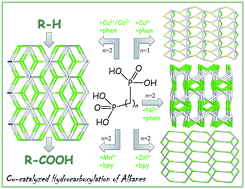Three-component 1D and 2D metal phosphonates: structural variability, topological analysis and catalytic hydrocarboxylation of alkanes†
Abstract
Herein, we report the use of diphosphonate building blocks and chelating auxiliary N,N-ligands to generate novel polymeric architectures. Specifically, we report new 1D and 2D coordination polymers incorporating three components: transition metal ions (Co2+, Cu2+, Mn2+ or Zn2+), diphosphonate ligands (methane-diphosphonate, MDPA, or 1,2-ethanediphosphonate, EDPA) and N,N-heterocyclic chelators (1,10-phenanthroline, phen, or 2,2′-bipyridine, bpy). Six compounds were isolated under mild synthesis (ambient temperature) conditions: [Cu2(phen)2(EDPA)2(H2O)4]∞ (1), [Co(phen)(EDPA)(H2O)2]∞ (1a), {[Cu(phen)(MDPA)]·H2O]}∞ (2), [Mn(bpy)(EDPA)(H2O)2]∞ (3), [Zn(bpy)(EDPA)]∞ (4), and, lastly, a discrete Ni2+ molecular derivative [Ni(phen)(H2O)4](EDPA) (5). Synthetic details, crystal structures, and intermolecular interactions (π–π stacking and hydrogen bonding) in 1–5 are discussed. Topological analyses and classification of the underlying metal–organic networks in 1–4 were performed, revealing the uninodal 1D chains with the 2C1 topology in 1–3 and the binodal 2D layers with the 3,4L13 topology in 4. In 1–3 and 5, multiple hydrogen bonds lead to the extension of the structures to give 3D H-bonded nets with the seh-4,6-C2/c topology in 1 and 3, 2D H-bonded layers with the 3,5L52 topology in 2, and a 3D H-bonded net with the 6,6T1 topology in 5. The catalytic activity of compounds 1 and 1a was evaluated in a single-step hydrocarboxylation of cyclic and linear C5–C8 alkanes to furnish the carboxylic acids with one more carbon atom. These reactions proceed in the presence of CO, K2S2O8, and H2O at 60 °C in MeCN/H2O medium. Compound 1 showed higher activity than 1a and was studied in detail. Substrate scope was investigated, revealing that cyclohexane and n-pentane are the most reactive among the cyclic and linear C5–C8 alkanes, and resulting in the total yields of carboxylic acids (based on substrate) of up to 43 and 36%, respectively. In the case of cycloalkane substrates, only one cycloalkanecarboxylic acid is produced, whereas a series of isomeric monocarboxylic acids is generated when using linear alkanes; an increased regioselectivity at the C(2) position of the hydrocarbon chain was also observed.



 Please wait while we load your content...
Please wait while we load your content...